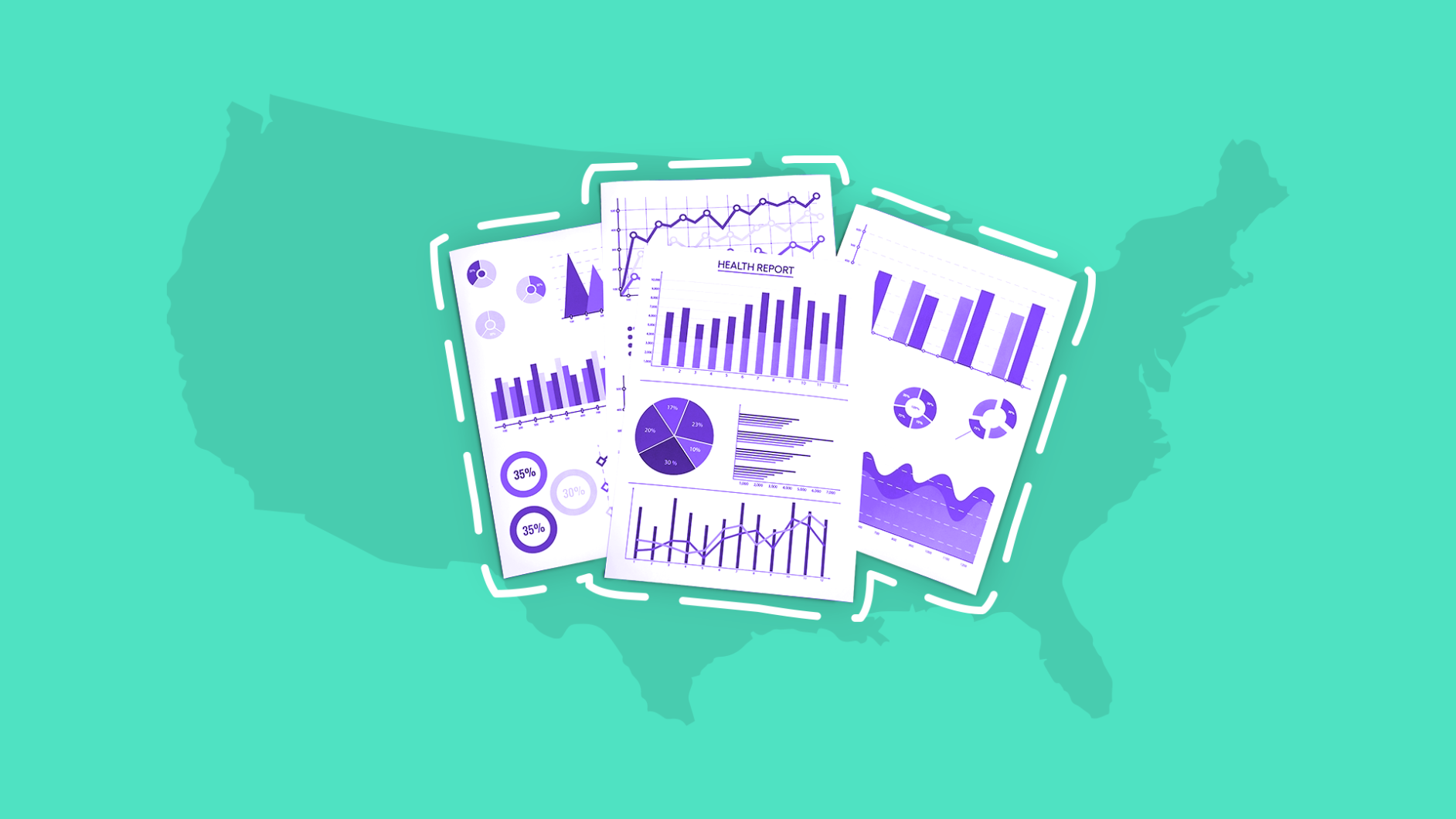What is mental illness? | How common is mental illness? | Global mental health statistics | U.S. mental health statistics | Mental health treatment | Resources | Research
Mental health and substance use disorders affect 13% of the world’s population. That number could increase as people around the world shelter in place and adjust to a new normal amid the coronavirus pandemic. In our national survey on mental health and coronavirus, we found that the COVID-19 pandemic has affected the mental health of 59% of people in the United States. Dismantling the stigma around mental illness is important now more than ever. The following mental health statistics illustrate the scope and impact of mental illness.
What is mental illness?
Mental illness comprises two categories—those with any mental illness (AMI) and those with serious mental illness (SMI), though these are not mutually exclusive.
AMI is defined by the Substance Abuse and Mental Health Services Association (SAMHSA) as having any mental, emotional, or behavioral health disorder that met the Diagnostic and Statistical Manual of Mental Disorders, 4th edition (DSM-IV) criteria. A person with an AMI is defined as having an SMI by SAMHSA if their disorder substantially interferes with or limits one or more major life activities.
Some mental health conditions include:
- Anxiety: Anxiety disorders are characterized by persistent worry, fear, and stress that interferes with one’s everyday life.
- Depression: Persistent low mood, fatigue, and profound sadness are prominent symptoms of major depression.
- Substance use disorders: The frequent use of alcohol and/or drugs that interferes with a person’s behavior in day-to-day life.
- Bipolar disorder: Bipolar disorder consists of radical shifts in depressive or “low” moods and manic “high” moods that can last weeks long.
- Schizophrenia: Schizophrenia is a chronic and severe mental disorder that affects a person’s thoughts, feelings, and behaviors
- Eating disorders: Eating disorders are illnesses that affect a person’s relationship with food and body image.
- Obsessive-compulsive disorder (OCD): OCD is a chronic, long-lasting anxiety disorder where a person experiences unreasonable, uncontrollable, recurring thoughts followed by a behavioral response.
- Post-traumatic stress disorder (PTSD): PTSD is a disorder that develops in some who have experienced a shocking or dangerous event and have difficulty recovering from the trauma the event caused.
How common is mental illness?
- 970 million people worldwide have a mental health or substance abuse disorder. (Our World in Data, 2018)
- Anxiety is the most common mental illness in the world, affecting 284 million people. (Our World in Data, 2018)
- Globally, mental illness affects more females (11.9%) than males (9.3%). (Our World in Data, 2018)
- Major depression, anxiety, alcohol use disorders, schizophrenia, bipolar disorder, and dysthymia (persistent mild depression) were identified as leading causes of disability in the U.S. (U.S. Burden of Disease Collaborators, 2013)
- The mortality rate of those with mental disorders is significantly higher than the general population, with a median life expectancy loss of 10.1 years. (JAMA Psychiatry, 2015)
- It is estimated mental disorders are attributable to 14.3% of deaths worldwide, or approximately 8 million deaths each year. (JAMA Psychiatry, 2015)
RELATED:
Mental health statistics worldwide
- Anxiety affects 284 million people in the world.
- Depression affects 264 million people.
- Alcohol use disorder affects 107 million people.
- Drug use disorder affects 71 million people.
- Bipolar disorder affects 46 million people.
- Schizophrenia affects 20 million people.
- Eating disorders affect 16 million people.
Our World in Data, 2018
Mental health statistics in the U.S.
- More than a quarter (26.3%) of adults aged 18 to 25 years old had any mental illness in 2018.
- Nearly 8% of adults aged 18 to 25 years old had a serious mental illness in 2018.
- Anxiety disorders affect 40 million adults in the U.S. (18.1% of the population) making them the most common mental illness. (Anxiety and Depression Association of America)
- The rate of individuals aged 18 to 25 years old that reported symptoms consistent with major depression increased 63% from 2009 to 2017. (American Psychological Association, 2019)
(SAMHSA, 2018)
Mental health treatment
Mental health treatment varies among the types of mental disorders. Those seeking treatment should consult a medical or mental health professional to discuss the range of therapies and medications that are the best fit for them.
Treatment can be expensive, with costs of therapy and medication scaling thousands of dollars. The U.S. spent $187.8 billion on mental health conditions and substance use disorders in 2013. Seventy billion of that cost was spent on depression treatment alone.
According to a study published by Lancet Psychiatry, the total cost of treatment of anxiety and depression disorders across 36 countries worldwide is estimated to be $147 billion by 2030. This cost will produce a net benefit, based on an estimated and modest 5% improvement in work productivity resulting in a $399 billion economic gain.
Does insurance cover mental health services?
All Marketplace health insurance plans cover mental health and substance abuse services, according to healthcare.gov. These services include psychotherapy, counseling, inpatient services, and substance use disorder treatment. Additionally, Marketplace plans can’t deny you coverage for having a pre-existing mental health condition.
Furthermore, Medicaid is “the single largest payer for mental health services in the United States.”
As far as Medicare coverage goes, Medicare Part A covers hospitalizations, including admissions due to mental health problems, and Medicare B covers mental health visits. Here’s a full list of covered services.
A study conducted in 2006 estimated the average charges, cost to provide care, and the amount of reimbursement for inpatient psychiatric care in 418 community-based hospitals in the U.S.
Average cost to deliver treatment to those with Medicare:
- Schizophrenia treatment: $8,509 for 11.1 days
- Bipolar disorder treatment: $7,593 for 9.4 days
- Depression treatment: $6,990 for 8.4 days
Unfortunately, according to the 2006 study, uninsured patients are more likely to receive suboptimal care. Notice that treatment duration for uninsured patients is shorter than treatment for the insured.
Average cost to deliver treatment for those who are uninsured:
- Schizophrenia treatment: $5,707 for 7.4 days
- Bipolar disorder treatment: $4,356 for 5.5 days
- Depression treatment: $3,616 for 4.4 days
(Psychiatric Services, 2012)
Mental health treatment statistics
The National Survey on Drug Use and Health defines mental health services as receiving inpatient or outpatient treatment or counseling or taking prescription drugs for mental health problems.
- 15% of American young adults (aged 18 to 25) received mental health care in one year. (SAMHSA, 2018)
- A quarter of college students have mental health disorders such as anxiety, depression, and alcohol use disorder. (Psychological Services, 2020)
- The majority (93%) of students are aware of on-campus services related to mental health. (American Psychological Association, 2018)
- Only 13% of students with a mental health problem utilize on-campus resources, such as counseling. (American Psychological Association, 2018)
- Less than a third of white adolescents do not receive mental health services, but half of minority adolescents do not receive needed care. (The National Alliance to Advance Mental Health, 2007)
- More than half of young people who have been involved with the juvenile justice system meet the criteria for at least one psychiatric disorder, yet only 15% of them have received treatment. (Office of Juvenile Justice and Delinquency Prevention, 2017)
Treatment and medication guides
If you’ve been diagnosed with one of the following mental health conditions, you can use these guides to better understand the treatment options available to you and compare commonly prescribed medication. However, the only one who can determine the best treatment for you is your healthcare provider.
- Anxiety
- Depression
- Obsessive-compulsive disorder (OCD)
- Schizophrenia
- Post-traumatic stress disorder (PTSD)
- Bipolar disorder
- Attention deficit hyperactivity disorder (ADHD)
Mental health resources
If you are experiencing symptoms of mental illness and/or having suicidal thoughts, help is available. Use the following support groups and lifelines to get the care you need.
- National Suicide Prevention: 1-800-273-8255
- Crisis text line: Text HOME to 741741 to connect with a crisis counselor
- Substance Abuse and Mental Health Services Administration National Helpline: 1-800-662-4357
- Behavioral health treatment services locator
- Substance use disorder treatment locator
Research:
- Mental health, Our World in Data
- Key substance use and mental health indicators in the United States, Substance Abuse and Mental Health Services Association
- The state of U.S. health, 1990-2010: Burden of diseases, injuries, and risk factors, U.S. Burden of Disease Collaborators
- Mortality in mental disorders and global disease burden implications, JAMA Psychiatry
- Any anxiety disorder, National Institute of Mental Health (NIMH)
- By the numbers: The cost of treatment, American Psychological Association
- An examination of costs, charges, and payments for inpatient psychiatric treatment in community hospitals., Psychiatric Services
- Scaling-up treatment of depression and anxiety: a global return on investment analysis, Lancet Psychiatry
- Training psychologists to address social determinants of mental health, Training and Education in Professional Psychology
- The relationship between on-campus service utilization and common mental health concerns in undergraduate college students, Psychological Services
- Ethnic and gender disparities in needed adolescent mental health care, The National Alliance to Advance Mental Health
- Intersection between mental health and the juvenile justice system, Office of Juvenile Justice and Delinquency Prevention
- Facts & statistics, Anxiety and Depression Association of America
- Mental health issues increased significantly in young adults over the last decade, American Psychological Association, 2019











